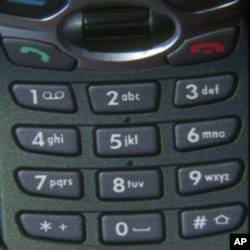Information technology has come more slowly to the area of health care perhaps than some other fields. But the field of e-health, as it's called, is moving forward, and some of the most notable advances are happening in developing countries.
E-health can be as complicated as a national database of medical records or as simple as a daily text message reminding you to take your medicine.
The journal Health Affairs devotes its February issue to "E-Health in the Developing World," focusing on countries where mobile phone use is skyrocketing and where clinics and hospitals are not encumbered by entrenched systems and procedures.
In fact, being a rich Western nation isn't necessarily an advantage when it comes to e-health and its mobile phone-based cousin, m-health. For example, here in the U.S., medical records are still mostly kept on paper, and most doctors still rely more on fax than e-mail.
Health Affairs editor Susan Dentzer says the rapid advance of information technology, along with declining prices, presents what she calls a spectacular opportunity in poor and middle-income nations.
"We know that this is already happening in remote clinics, for example in Rwanda, where cell phone-based technologies are being used to keep track of dispensation of drugs to patients with HIV," said Dentzer. And Rwanda is actually at the leading edge of developing nations in tapping these technologies to advance health and health care."
A project in South Africa, Project Masiluleke, put an HIV awareness message in the unused space of certain text messages. That produced a four-fold increase in calls to the national AIDS helpline.
Walter Curioso of the University of Washington describes a program in Peru where AIDS patients get a text message reminding them to take their medicine. But from focus groups, they learned that potential users of the service had concerns about privacy.
"They didn't want a message that says 'it's time to take your antiretroviral pill.' And instead," he said, "they would like to receive a message that uses some kind of code, and instead of sending a message that reminds them of their pill, they would like a motivational message, like for example, 'it's time for your life.'"
Services like that have been shown to work in low-income countries, and now they're starting to appear in richer countries.
One is a new, phone-based service for expectant mothers from Voxiva, a firm which develops interactive mobile health services. Company co-founder Pamela Johnson says the inspiration for the new product comes from the success of m-health initiatives in developing countries.
"Text4baby is the first real m-health service launched in the United States focused on pregnant women, where women can text 51141 Baby or Bebe and register for messages during pregnancy and for the first year of life," Johnson said. "To me this is a very exciting development of true South-North collaboration."
Information technology also has strong potential in hospitals and clinics. But William Hersh of the University of Oregon said it's important to ensure that new technologies actually help patients and the doctors and nurses who serve them.
"Any time you introduce information technology anywhere, but especially in health care organizations, you need to be cognizant of the clinical work flow. You can't make life worse for clinicians. And you also have to understand the local needs and capabilities, which I think we see with m-health and emerging technologies there."
Writing in Health Affairs, Hersh stresses the need for a well-trained workforce in developing countries who can bring the advantages of information technology to the health care setting.
Collecting patient data or ordering drugs and lab tests using handheld devices can be very effective in reducing errors. Hamish Fraser of the U.S.-based non-profit group Partners in Health, says several studies have demonstrated how the technology can help patients.
"There's really clear evidence, as there has been in the United States for example, that getting a good laboratory system together that can actually report this data directly to the clinicians can really impact on the accuracy, the timeliness and the use of that data."
But Fraser says information technology specialists may have a tendency to focus on the technology and not see things from the user's point of view. So, for example, one risk is in trying to collect too much information.
"There would be an eight-page form, and really other sites have successfully managed to make this work with one page, and that data quality is much better in one page, because it's easier to do. I think, to me, that is the biggest mistake."
You can learn more about what happens when information technology meets health care at the Health Affairs magazine website, healthaffairs.org.






